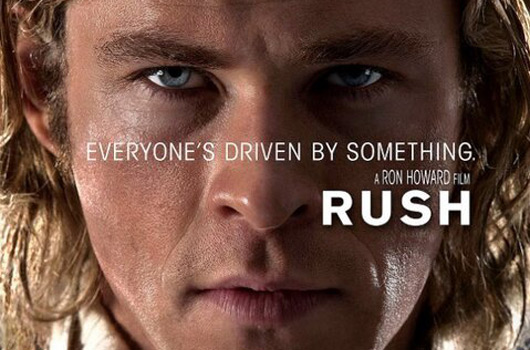After the success of 2012’s Argo, studios were looking for more “based on a true story” 70’s period pieces. And why not go with what has to be one of the biggest rivalries in racing history – the story of Nikki Lauda and James Hunt – two F1 drivers that started in 1970 and escalated their rivalry into what some say is the most exciting Grand Prix in history in 1976.
Ron Howard directed a very compelling and intense movie surrounding the lives of Lauda (Daniel Bruhl) and Hunt (Chris Hemsworth). Both had different styles in life and in driving but what had started rough between the two ended in friendship years later.
Everyone’s driven by something.
Rush is told in two parts where part one is the first hour where both characters give narratives on their early lives in 1970 and we see who they started from F3 racers and gradually making their way to the racers they became by the mid-70’s. Part two is their lives as told in a straight forward linear fashion dealing with the events of 1976 and how their drive to succeed has gotten them to where they are.
James Hunt is a womanizing, drinking all night, playboy who likes to live life like he drives – fast and hard. Nikki Lauda thinks before he speaks, is calculates all he does, and follow the rules. Both were disowned by their families for wanting to race and not follow in their father’s footsteps. Realizing that getting far in F3 (a minor league to the Formula 1 racing or F1 as it’s called) isn’t as far as he’d like to go, Lauda invest money into an F1 team that is down on their luck. He teaches them how to make the cars faster and lighter and eventually becomes friends with that team’s driver Clay Regazzoni (Pierfrancesco Favino). Clay takes Lauda with him when Enzo Ferrari signs them to race for his team and cars.
Hunt was driving for Hesketh and they moved their F3 team into the F1 terratory which was seen by the other drivers a party group that was just in it for the girls and the booze. Eventually Lord Hesketh (Christian McKay) realized that you need sponsors in order to survive the costs of F1 and since they didn’t meet the sponsor deadline, Hesketh closed their doors in 1975. Hunt eventually signed to drive with McLaren in 1976 and now was on “equal grounds” with Lauda allowing their rivalry to continue.
The gritty nature of Rush is shown via the cinematography as Cinematographer Anthony Dod Mantel (thank you IMDB for that pull) uses a washed out appearance on his colors giving everything an old look and feel. Both Dod Mantel and Howard have use POV to make you feel like you’re in the race (and not get you motion sick while doing this). You get an up close look into world of racing and it really adds to the experience.
This is an R-rated movie that has use of drugs, nudity, language, and one sequence of graphic injuries. Rush depicts the crash in 1976 at the German Grand Prix where Lauda was badly burned when his car swerved off the track due to heavy rain that had been hitting the area that day. Earlier in the day he tried to get a vote of the drivers to cancel the race and after Hunt managed to sway the group into keeping the race going, Lauda crashed because of a bad wheel jack that had jammed due to a dire change after the first lap. After six weeks away (and still badly scared), Lauda returned to race and both thanked and blamed Hunt for the return – as it was their rivalry that motivated him to return and get out of the hospital but also his chance to win the 1976 championship and repeat from his 1975 title.
Rush is a fast paced and intense movie that runs 2 hours in length but feels faster (pun intended).
I give this 4 out of 5 stars.


Leave a Reply